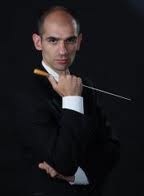|
Choral and Vocal
CANTIAMO SONOMA'S LUSCIOUS A CAPELLA SINGING IN SEASON ENDING CONCERT
by Pamela Hicks Gailey
Sunday, June 8, 2025
Symphony
SRS SEASON ENDS WITH RESOUNDING TA-TA-TA-BANG
by Terry McNeill
Sunday, June 1, 2025
Symphony
YOUTHFUL VIRTUOSITY ON DISPLAY AT USO'S MAY CONCERTS
by Peter Lert
Saturday, May 17, 2025
Symphony
MYSTICAL PLANETS AND LIVELY GERSHWIN ORTIZ AT FINAL SRS CONCERT
by Peter Lert
Sunday, May 4, 2025
Symphony
VSO'S CONCERT MUSIC OF TIME, MUSIC OF PLACE
by Peter Lert
Sunday, April 27, 2025
VOCAL ELEGANCE AND FIRE AT THE 222'S RECITAL APRIL 26
by Pamela Hicks Gailey
Saturday, April 26, 2025
CANTIAMO SONOMA SINGS AN INSPIRED GOOD FRIDAY MOZART REQUIEM CONCERT
by Pamela Hicks Gailey
Friday, April 18, 2025
DRAMATIC SHOSTAKOVICH SYMPHONY CLOSES PHILHARMONIC'S 25TH SEASON
by Terry McNeill
Sunday, April 13, 2025
LARGE COLLEGE OF MARIN AUDIENCE GREETS STOPHER ARTISTRY
by Terry McNeill
Saturday, April 5, 2025
Chamber
FRISSON DELIVERS SHIVERS OF DELIGHT
by Abby Wasserman
Sunday, March 30, 2025
|
 |
 Jovan Zivkovic |
NORTHERN LIGHTS SHINE BRIGHTLY
by Terry McNeill
Saturday, November 17, 2012
Programming an orchestra concert with Nordic music would seem to be simplicity itself: Grieg for romantic themes, Sibelius for instrumental virtuosity, Nielsen for a 20th-century harmonic component. The combination worked to perfection in the American Philharmonic Sonoma County’s Nov. 17 “Northern Lights” concert in Santa Rosa High School’s Performing Arts Auditorium.
Guest conductor Jovan Zivkovic kept a firm hand on the sonic proceedings, generating the same cogent and balanced sound heard when music director Norman Gamboa opened the season in October. Zivkovic used expansive tempos in the first piece, Grieg’s first suite from the Op. 46 incidental music to “Peer Gynt.” The “Morning” section featured richly hued clarinet playing from Ken Ward. The three soft and somber chords ending the “Death of Ase” segment were perfectly gauged, as was the pizzicato playing in the finale (the famous “Hall of the Mountain King”), beginning in the basses and joined by the horns and subsequently strings. It was not transparent playing, but there was good ensemble throughout.
The Sibelius Violin Concerto followed, with the APSC’s Young Artist Award winner Stephen Waarts as soloist. Long a staple in the standard repertoire, the concerto received a committed performance by Mr. Waarts. Occasionally he had trouble taking notes cleanly coming out of fast bass register passages, but his top notes were brilliantly played with sure-footed intonation. He was able to vary his vibrato as the music’s tempo changed, and the big trill in the first-movement cadenza grew with expression.
Mr. Zivkovic, a restrained conductor with precise but not extravagant stick movements, carefully controlled the shimmering slow movement. Mr. Waarts played the twice-repeated ascending passage soulfully, each time taking the repeat pianissimo. The concluding Allegro was full of scrappy orchestra playing, occasional intonation difficulties in the strings, and fast passage work for the soloist.
Perhaps due to the APSC getting used to the new hall, which this evening had an audience of 300, the soloist was often covered by the orchestra. They were simply too loud, notwithstanding the thematic projection from Mr. Waarts. Afterwards, the soloist offered an extended encore, Paganini’s C Minor Caprice, Op. 1, with copious multiple instrumental stops in difficult hand positions, and he played it adroitly.
Nielsen’s Fifth Symphony, a 30-minute work of grand contrasts and great emotional impact, closed the program. Nichikas Xenelis's suave clarinet and the horn section began the first of two movements over a viola ostinato, the martial character continually reminding one of early Shostakovich. However, Nielsen’s work came four years before Shostakovich’s Symphony No. 1. The menace and visceral nature of the music were kept in balance by the conductor. Percussionist Joe Lang was the persistent and obtrusive snare drummer throughout the first movement.
In the final Allegro, the music’s themes quietly and subtly appeared, leading to strong outbursts by the brass sections, and finally a surging fugal part beginning with the first violins, then violas and bassoonists Miranda Kincaid, Steve Peterson and Mary Ann Sacksteder. There were screeching bird call phrases from the winds, broken by bits of rhapsodic and even bucolic music. Emily Reynolds’ flute playing in the finale was outstanding and echoes of another contemporary of Nielsen, Bartok, appeared in the sonic mix. Good company.
The Nielsen symphony was the highlight of the concert, and it received an incisive and comprehensive interpretation under Mr. Zivkovic’s baton. For the next day’s performance, the audience reportedly doubled in size, nearly filling the hall. The word got around.
|
